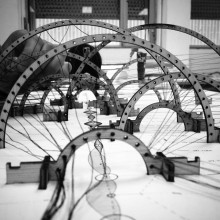AA Visiting School Barcelona. Bodega, Enological Metabolism.

“The AA Visiting School defies categorisation.” This is how the unique programmes of the visiting school —organised by the Architectural Association School of Architecture in London— define themselves. The experience is based on a wide-ranging programme of exhibitions, lectures, symposia and publications which have given it a central position in global discussions and developments within contemporary architectural culture.
This year, from 3rd – 17th of July 2014, in collaboration with the Escola Tècnica Superior d’Arquitectura de Barcelona – UPC BarcelonaTECH, the AA Visiting School will research the topic of “Bodega, Enological Metabolism”. The program can be described with the following texts:
Bodega – Enological Metabolism
The programme is again revolving around the idea of working on associations that exist between wine and architecture, furthermore to search for their interdependence and the influences that they may have on one another. The workshop this year will be the occasion to discover the fascinating cultural patrimony left by the Catalan modernist architects of the so called “Wine Cathedrals” in southern Catalonia.
Emerging as a peculiar building typology in the early 20th century, the modernist winery seems to articulate a reciprocal relationship between wine and its process of making, between the apparatus and the structure, between the content and the container. Can these buildings be understood as machines? How do structure, materials and spatial organisations relate to the process of wine making? What are all the interlaced systems and strategies that exist within these delicate yet astonishing constructions and their context?
The workshop will run as two parallel experiments occurring simultaneously along the two weeks of the course. One as an exploration on the senses, using wine as raw material, will happen as 1:1 performing installations, empirically testing and provoking unusual sensorial reactions on the body. The other, initiated from a methodological understanding of constructive, structural and spatial affinities of the modernist bodega, will lead to the design of new models, or even buildings, for a contemporary winery. Using digitally advanced techniques, these latter explorations will take the form of large scale maps and physical models.
Live Sensorial Laboratory
Wine awakes our sense, such as taste or smell, but what other sensorial reaction can it trigger?
The jargon of the enologist, when he describes taste as a sensorial experience, is all but tangible, yet amazingly precise. He needs to employ the metaphor to relate physical images and sensorial reactions.
Wine does carry images, its taste evokes particularities of the context in which the fruit grew, the flavour reflects the climate, and the colour witnesses its fermentation and aging, the soft smell nuances refer to olfactory perceptual memories… Our body is therefore capable of detecting, through its senses, this endless range of details embedded in the complex process of winemaking, while our mind often seems not to sense it at all…
Playfully creating a “mise-en-scene” with wine, students will explore sensorial experiences that the liquid is not known to usually provoke. We will take the wine out of the glass, into the space, into the air, confronting it to light, heat, wind…
This part of the work will run as a continuous experiment, starting on day one, ending during the final presentation of the workshop!
A corner of the ETSAB will be set up as a “laboratory” where white and red will be predominant. The student, acting as an artist, or a scientist, will be dressed in white and, equipped with photographic, filmic or graphic means, will invent new machinic devices to discern and enhance special nuances of the wine. We will design decanter-like pieces to trigger new or hidden effects that wine can have on our senses.
Winery: Content and Container
The title refers to the inherent symbiosis that exists between wine making and the edifice as its host. The winery is a machine where interlocked mechanisms perform through time, it’s unclear where the building stops and the winemaking starts, the content and the container can therefore no longer be identified and furthermore, dissociated.
The core exercise of the workshop will depart from an onsite cartographical analysis of the wine cathedrals of the modernist movement. We will read the bodega as a set of interlaced systems, occurring in time, orchestrating all the aspects of architecture and wine making: space, structure, light, climate, services, circulation, machines, processes, and transport. With the data collected during the field trip, students will have to describe graphically the way in which they understand these systems and relations. The outcome of this analysis will be formalised as drawings or maps, test models and form-finding experiments, that attempt to dismantle or dissect the systems that compose the winery.
These drawings will come together into one large map which will form the ground for the construction of a large collaborative model both integrating fragments of the historical winery and audaciously propose its reinvention.
We will tackle drawing and model-making with the contribution of digital tools, may they help us to think about cartography, about design, about making… Parametric design will be part of the learning agenda of the workshop. Support in drawing, 3d-modelling, parametric modelling, physical fabrication will be provided by a team of experts.
The results, as models and drawings, will be presented on the last day of the workshop to a panel of experts from the architecture and enological world, in a public presentation preceding the keynote lecture.
/// More info at AA Visiting School Barcelona









